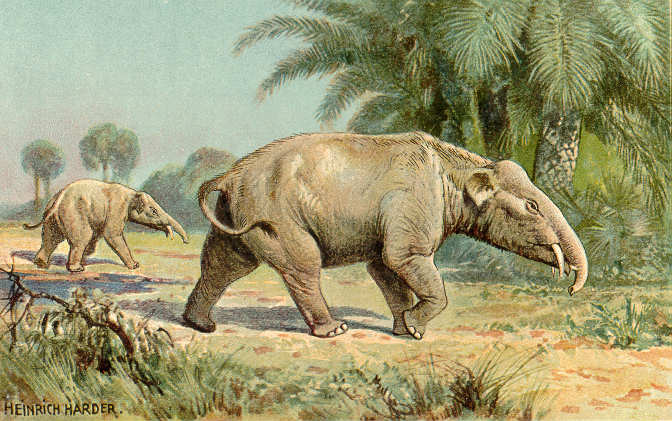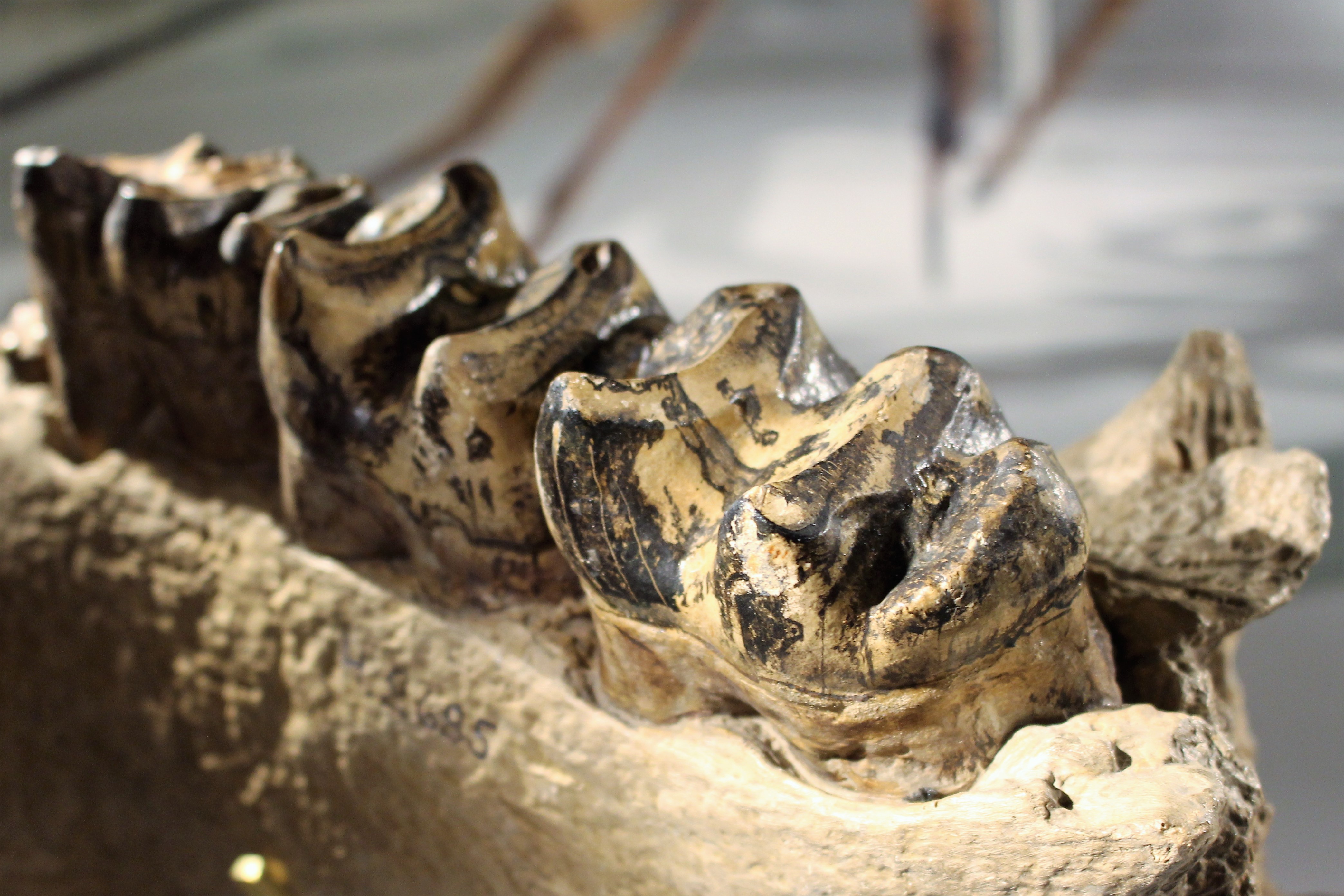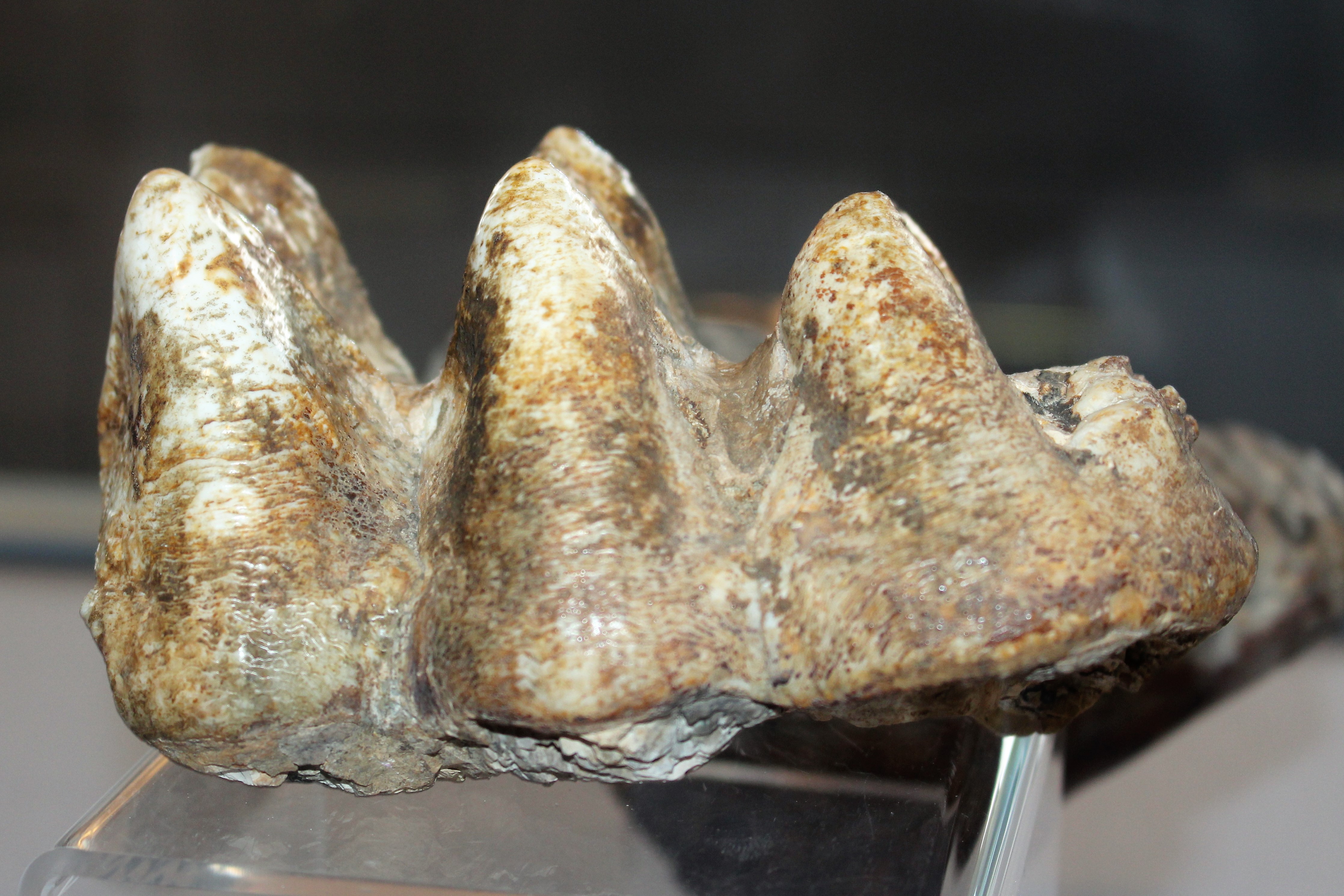|
Elephantiformes
Elephantiformes is a suborder within the order Proboscidea. Members of this group are primitively characterised by the possession of upper tusks, an elongated mandibular symphysis (the frontmost part of the lower jaw) and lower tusks, and the retraction of the facial region of the skull indicative of the development of a trunk. The earliest known member of the group, '' Dagbatitherium'' is known from the Eocene (Lutetian) of Togo, which is only known from isolated teeth, while other primitive elephantiforms like '' Phiomia'' and '' Palaeomastodon'' are known from the Early Oligocene onwards. ''Phiomia'' and ''Palaeomastodon'' are often collectively referred to as "palaeomastodonts" and assigned to the family Palaeomastodontidae. Most diversity of the group is placed in the subclade Elephantimorpha, which includes mastodons (family Mammutidae), as well as modern elephants and gomphotheres (Elephantida), which are distinguished from more primitive elephantiforms by the development ... [...More Info...] [...Related Items...] OR: [Wikipedia] [Google] [Baidu] |
Dagbatitherium
''Dagbatitherium'' is an extinct genus of proboscideans. So far a single molar from the phosphate basins of Togo in West Africa has been found. The fossil dates to the Middle Eocene, around 47 million years ago. A striking feature of the tooth are the three pairs of cusps oriented transversely to the longitudinal axis of the tooth. This feature is found in more derived proboscideans, which are grouped in the Elephantiformes. For its age, ''Dagbatitherium'' is the earliest elephantiform to date. Furthermore, it is characterized by a low tooth crown and a humped occlusal pattern. The genus was described in 2021. Discovery and naming The only tooth of ''Dagbatitherium'' found so far is from West Africa and was recovered in the Hahotoé-Kpogamé phosphate complex. These are phosphate-bearing deposits formed in a coastal basin. They extend over a length of 30 to 35 km and a width of 2 to 3 km in a northeast-southwest direction between the towns of Dagbati and Aveta in Togo. First exp ... [...More Info...] [...Related Items...] OR: [Wikipedia] [Google] [Baidu] |
Proboscidea
Proboscidea (; , ) is a taxonomic order of afrotherian mammals containing one living family (Elephantidae) and several extinct families. First described by J. Illiger in 1811, it encompasses the elephants and their close relatives. Three living species of elephant are currently recognised: the African bush elephant, the African forest elephant, and the Asian elephant. Extinct members of Proboscidea include the deinotheres, mastodons, gomphotheres and stegodonts. The family Elephantidae also contains several extinct groups, including mammoths and '' Palaeoloxodon''. Proboscideans include some of the largest known land mammals, with the elephant '' Palaeoloxodon namadicus'' and mastodon ''"Mammut" borsoni'' suggested to have body masses surpassing , rivalling or exceeding paraceratheres (the otherwise largest known land mammals) in size. The largest extant proboscidean is the African bush elephant, with a world record of size of at the shoulder and . In addition to thei ... [...More Info...] [...Related Items...] OR: [Wikipedia] [Google] [Baidu] |
Elephantiformes
Elephantiformes is a suborder within the order Proboscidea. Members of this group are primitively characterised by the possession of upper tusks, an elongated mandibular symphysis (the frontmost part of the lower jaw) and lower tusks, and the retraction of the facial region of the skull indicative of the development of a trunk. The earliest known member of the group, '' Dagbatitherium'' is known from the Eocene (Lutetian) of Togo, which is only known from isolated teeth, while other primitive elephantiforms like '' Phiomia'' and '' Palaeomastodon'' are known from the Early Oligocene onwards. ''Phiomia'' and ''Palaeomastodon'' are often collectively referred to as "palaeomastodonts" and assigned to the family Palaeomastodontidae. Most diversity of the group is placed in the subclade Elephantimorpha, which includes mastodons (family Mammutidae), as well as modern elephants and gomphotheres (Elephantida), which are distinguished from more primitive elephantiforms by the development ... [...More Info...] [...Related Items...] OR: [Wikipedia] [Google] [Baidu] |
Phiomia
''Phiomia'' (after the Ancient Greek ''phiom'' "lake", an ancient name for the Fayum), is an extinct genus of basal elephantiform proboscidean that lived in what is now Northern Africa during the Late Eocene to Early Oligocene some 37–30 million years ago. The type specimen of ''Phiomia'', part of the mandible (lower jaw), was described in 1902 by Charles William Andrews and Hugh John Llewellyn. Unsure of its identity, they assigned it, tentatively, to the obsolete order Creodonta. Subsequently, it was recognised as a proboscidean. Briefly it was treated as a junior synonym of ''Palaeomastodon'', but the two are regarded as separate genera. Though five species have been assigned to ''Phiomia'' over the years, only two, ''P. serridens'' (the type species) and ''P. major'', are currently recognised. ''Phiomia'' was fairly small in terms of body size, with an estimated shoulder height in the case of ''P. serridens''. In some regards it resembled ''Palaeomastodon'', though was les ... [...More Info...] [...Related Items...] OR: [Wikipedia] [Google] [Baidu] |
Palaeomastodon
''Palaeomastodon'' ("ancient mastodon") is an extinct genus of basal proboscideans from the Oligocene of North Africa. The first specimen discovered was recovered from strata belonging to the Fayum fossil deposits of Egypt. It was described and named in 1901 by Charles Williams Andrews, who named its type species, ''P. beadnelli'', after a colleague. Multiple species have been named since, though have either been reassigned to '' Phiomia'' or synonymised with ''P. beadnelli''. Three (possible) unnamed taxa are known from Ethiopia and Libya. All remains are from strata that date to 33–27 million years ago. ''Palaeomastodon'' was fairly large for an early proboscidean. It had an estimated shoulder height of , and a body mass of around . Similar to ''Phiomia'', its nasal cavity was retracted and surrounded by strong muscle attachment sites, indicating that it was among the first proboscideans to possess a trunk. Like in modern elephants, the orbits (eye sockets) were positioned ... [...More Info...] [...Related Items...] OR: [Wikipedia] [Google] [Baidu] |
Elephantimorpha
Elephantimorpha is a clade of proboscideans that contains the Mammutidae (mastodons), as well as Elephantida ( amebelodonts, choerolophodonts, gomphotheres, stegodontids and elephantids). All members of Elephantimorpha have the horizontal tooth replacement typical of modern elephants, where the cheek teeth progressively migrate forwards in the jaw like a conveyor belt. This a distinctive characteristic of this group (synapomorphy) and is not found in more primitive non-elephantimorph Elephantiformes. Members of Elephantida are distinguished from mammutids by the reduced angular process of the lower jaw. Like modern elephants, the ancestor of Elephantimorpha was likely capable of communicating via infrasonic calls. While early elephantimorphs generally had lower jaws where the fused front part (the mandibular symphysis) was greatly elongated with well developed lower tusks/incisors, from the Late Miocene onwards, many groups convergently developed brevirostrine (shortened) lowe ... [...More Info...] [...Related Items...] OR: [Wikipedia] [Google] [Baidu] |
Deinotheriidae
Deinotheriidae ("terrible beasts") is a family of prehistoric elephant-like proboscideans that lived during the Cenozoic era, first appearing in Africa during the Oligocene then spreading across Europe and the lower latitudes of Asia during the Miocene epoch. Their most distinctive features were their lack of upper tusks and downward-curving tusks on the lower jaw. Deinotheres were not very diverse; the only three known genera are '' Chilgatherium'', ''Prodeinotherium'', and ''Deinotherium''. These form an evolutionary succession, with each new genus replacing the preceding one. Deinotheres were relatively conservative and showed little morphological change over their evolution, aside from a progressive increase in body size. Some species of ''Deinotherium'' are among the largest known land mammals ever, considerably exceeding modern elephants in size. The last members of ''Deinotherium'' persisted until the end of the Early Pleistocene in Africa, around 1 million years ago. De ... [...More Info...] [...Related Items...] OR: [Wikipedia] [Google] [Baidu] |
Phosphatherium
''Phosphatherium escuilliei'', named by Gheerbrant, Sudre and Cappetta in 1996, is a basal proboscidean that lived in Africa during the early Eocene, about 56-55 Ma. It is one of the earliest known proboscideans, together with ''Eritherium azzouzorum'' from the Selandian (about 60 Ma). It was found in phosphorites beds from the base of the Ypresian stage of the Ouled Abdoun Basin, which is best known for its exceptionally rich marine vertebrate fauna. Description The species ''P. escuilliei'' is known from relatively well-preserved fossils, including several sub-complete skulls that have enabled the reconstruction of the animal's head. The skull of ''Phosphatherium'' is very primitive compared to advanced proboscideans (Elephantiformes), for example the nasal openings are anterior, indicating that it lacked a trunk. Other plesiomorphic traits are the elongated face, the narrow rostrum, the strong sagittal and nuchal crests, the presence of an alisphenoid canal, the auditory ... [...More Info...] [...Related Items...] OR: [Wikipedia] [Google] [Baidu] |
Mastodon
A mastodon, from Ancient Greek μαστός (''mastós''), meaning "breast", and ὀδούς (''odoús'') "tooth", is a member of the genus ''Mammut'' (German for 'mammoth'), which was endemic to North America and lived from the late Miocene to the early Holocene. Mastodons belong to the order Proboscidea, the same order as elephants and mammoths (which belong to the family Elephantidae). ''Mammut'' is the type genus of the extinct family Mammutidae, which diverged from the ancestors of modern elephants at least 27–25 million years ago, during the Oligocene. Like other members of Mammutidae, the molar (tooth), molar teeth of mastodons have zygodont morphology (where parallel pairs of cusp (anatomy), cusps are merged into sharp ridges), which strongly differ from those of elephantids. In comparison to its likely ancestor ''Zygolophodon'', ''Mammut'' is characterized by particularly long and upward curving upper tusks, reduced or absent tusks on the lower jaw, as well a ... [...More Info...] [...Related Items...] OR: [Wikipedia] [Google] [Baidu] |
Moeritherium
''Moeritherium'' ("the beast from Lake Moeris") is an extinct genus of basal proboscideans from the Eocene of North and West Africa. The first specimen was discovered in strata from the Fayum fossil deposits of Egypt. It was named in 1901 by Charles William Andrews, who suggested that it was an early proboscidean, perhaps ancestral to mastodons, although subsequent workers considered it everything from a relative of manatees to a close relative of both clades' common ancestor. Currently, ''Moeritherium'' is seen as a proboscidean that, while fairly basal, predates the split between elephantiforms and deinotheres. Seven species have been named, though only three (''M. lyonsi'', ''M. gracile'', and ''M. chehbeurameuri''), are currently considered valid. ''Moeritherium'' is unusual even among basal proboscidean standards. Like many later members of the group, it had two sets of tusks: the ones on the upper jaw pointed downwards, while those of the mandible (lower jaw) were fla ... [...More Info...] [...Related Items...] OR: [Wikipedia] [Google] [Baidu] |
Saloumia
''Saloumia'' is an extinct genus of the order Proboscidea. It is one of the oldest members of the order and lived in the middle Eocene of Senegal. It is known only from a single molar, whose pronounced bumpy chewing surface indicates it is probably closely related to ''Moeritherium''. Description The genus is known only from a partial upper molar 10.7 mm long and 12.3 mm wide, missing the posterior section. The molar is smaller than those of ''Moeritherium'', but larger than those of '' Eritherium'' and ''Phosphatherium''. The tooth was low-crowned, more clearly than that of ''Moeritherium''. The masticatory surface had four cusps. However, their tips were apparently broken off before fossilization. The four cusps each formed two pairs, which were arranged perpendicular to the longitudinal axis of the tooth, giving it a bilophodont structure characteristic of early proboscideans. The front pair of cusps (the paracone and the protocone) had no additional ridges. The bas ... [...More Info...] [...Related Items...] OR: [Wikipedia] [Google] [Baidu] |




